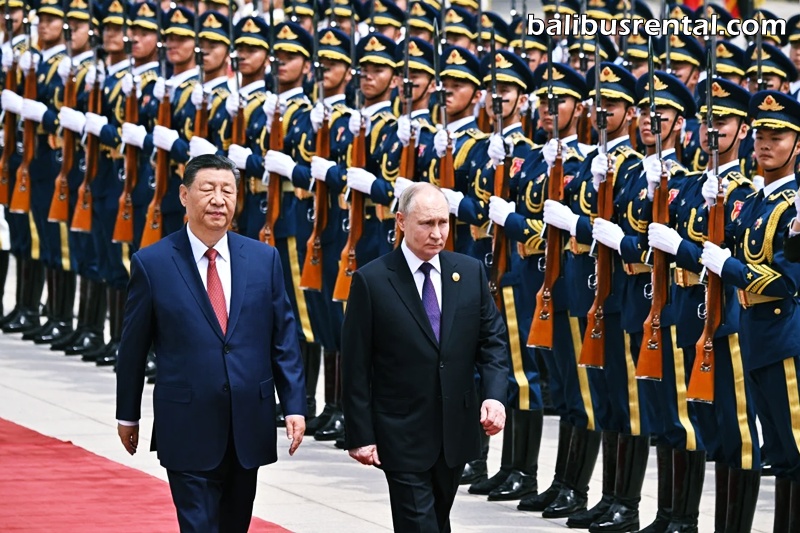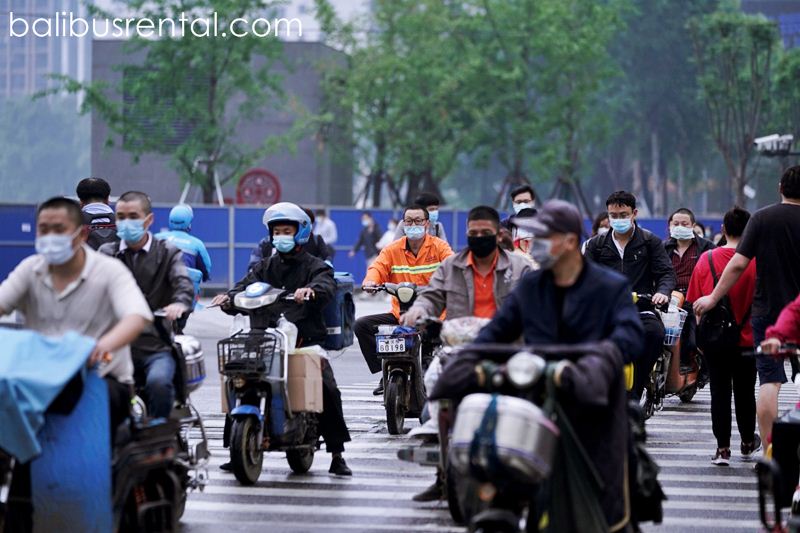Wednesday | 3rd September 2025
The huge military parade through central Beijing on Wednesday was a carefully orchestrated and deliberately fearsome display of weaponry, aimed not only at impressing domestic audiences but also at sending a calculated message to the world. China wanted to make it unmistakably clear that President Xi Jinping’s vision of a new global order, with Beijing at its apex, would not be mere rhetoric—it would be backed by a formidable arsenal of high-tech arms. Many of these weapons, on first impression, appeared to be on par with or even ahead of those fielded by China’s main rivals, including the United States.
While much of the immediate post-parade commentary will inevitably gravitate toward the unveiling of new long-range nuclear-armed systems—most notably the DF-61 intercontinental ballistic missile (ICBM)—military analysts suggest that other, perhaps subtler, technological developments may prove even more significant in the long run. Chief among them were China’s mobile, truck- and ship-mounted laser air defense weapons. These directed-energy systems, if already deployed in substantial numbers as Chinese officials hinted in pre-parade briefings, could radically alter the calculus of modern warfare in the Indo-Pacific. By potentially neutralizing incoming missiles, drones, and aircraft at a fraction of the cost of traditional interceptors, they would present serious obstacles for any adversary attempting to blunt Chinese military operations in the region.
That said, experts caution against prematurely declaring the People’s Liberation Army (PLA) the world’s most dominant fighting force. Many of the showcased systems remain untested in combat conditions, and questions persist about their reliability, scalability, and integration into broader operational doctrine. The parade was as much about symbolism and psychological effect as it was about battlefield reality.
Parade Highlights
The spectacle down Beijing’s most iconic boulevard, the Avenue of Eternal Peace, was overwhelming in its sheer scale. Hardware followed hardware in rapid succession, leaving little time to process the implications of each system before the next rolled into view. Still, several standout weapons drew particular attention:
- DF-61 ICBM: The star of the show was the DF-61, a massive new intercontinental ballistic missile carried on an eight-axle transporter-erector-launcher. This marks the PLA Rocket Force’s first new ICBM since the DF-41 debuted at the 2019 parade. The DF-61 underscores China’s commitment to expanding and modernizing its strategic nuclear deterrent.
- Hypersonic Glide Vehicles (HGVs): The parade also featured missiles equipped with HGVs—warheads capable of traveling at speeds exceeding Mach 5 while maneuvering unpredictably in flight. These qualities make them exceedingly difficult for traditional missile defense systems to track and intercept, further complicating strategic stability.
- Unmanned Systems: China showcased an impressive portfolio of drones across multiple domains. Extra-large unmanned submarines hinted at growing undersea capabilities, while advanced aerial drones were billed as potential “loyal wingmen” to support the PLA Air Force’s stealth fighter jets. On the ground, formations included robotic vehicles equipped with machine guns, mine-clearing tools, and logistical payloads, underscoring Beijing’s ambition to automate and augment battlefield operations.
- Directed-Energy Weapons: Two versions of laser systems were rolled out—one enormous, seemingly designed for naval air defense, and a smaller, truck-mounted version optimized for protecting ground forces. These belong to the broader class of “directed energy weapons,” which includes high-powered lasers and microwave systems. Unlike conventional weapons that rely on physical projectiles, these systems deliver destructive force through concentrated electromagnetic energy, capable of melting through targets, frying onboard electronics, or blinding critical sensors.
Directed-energy weapons are not only technically disruptive but also strategically advantageous. They promise significant cost savings, with each “shot” of a laser costing only a fraction of a missile or even a bullet. They also ease logistical burdens, since operators need only maintain an energy source rather than haul and store heavy ammunition stockpiles.
The Bigger Picture
Ultimately, the parade revealed two simultaneous truths about China’s military rise. On the one hand, Beijing is rapidly fielding advanced technologies designed to counter U.S. and allied capabilities, particularly in contested regions like the South China Sea and Taiwan Strait. On the other hand, much of what was displayed remains aspirational, with operational effectiveness still uncertain. For now, the PLA is demonstrating potential and intent rather than proven supremacy.
What is beyond doubt, however, is that China wants the world to know it is no longer a follower in military technology. Wednesday’s display was a bold signal that the balance of power in the 21st century is shifting—and that Xi Jinping intends for China to lead the charge.
An edge in industrial capacity
The sheer volume of military hardware on display underscored a critical point: China has not only the scientific and technological know-how, but also the industrial might to back up its ambitions—and, in time, perhaps to enforce Xi Jinping’s vision of a new global order. The message was unambiguous. This is not just a country developing prototypes or dabbling in advanced concepts; it is a state capable of producing high-tech weaponry at scale.
That industrial power is reminiscent of the United States in World War II, when American factories famously churned out ships, tanks, and aircraft in overwhelming numbers, eventually overwhelming the Axis powers. Wednesday’s parade was officially billed as commemorating the end of that war 80 years ago, but the historical echoes were clear. Where U.S. industrial capacity once ensured victory, America today struggles to replicate such output. By contrast, China’s state-directed manufacturing machine now seems poised to deliver weaponry on a scale the U.S. cannot easily match.
Malcolm Davis, senior analyst in defense strategy at the Australian Strategic Policy Institute (ASPI), put it bluntly:
“What the Chinese are demonstrating here is an ability to develop advanced military capabilities by themselves, deploy them operationally, and do it faster than what you’re seeing happen in the West. And also do it in larger volume in terms of sheer numbers of weapons deployed.”
Numbers Leaning Toward Beijing
The data appear to support that assessment. A report from the Center for Strategic and International Studies (CSIS), published on the eve of the parade, laid out just how far China has come. Beijing’s defense budget has grown thirteenfold over the past 30 years. While the U.S. still spends roughly three times as much on defense, China has been narrowing the gap, slicing it in half in just the past 12 years.
More importantly, China dominates at the regional level. According to CSIS researchers Matthew Funaiole and Brian Hart, Beijing now spends five times as much on defense as Japan and nearly seven times as much as South Korea—both key U.S. allies. This asymmetry reshapes the military balance in East Asia, placing Washington in the difficult position of trying to reassure allies while facing a peer competitor with greater local mass.
The sharpest contrast, however, emerges at sea. CSIS projects that by 2030 China will have 48% more battle force ships than the U.S. Navy. A 2023 study by a U.S. Naval War College professor, surveying the history of maritime conflicts, found that in naval wars, the side with the larger fleet almost always prevails. Quantity, in other words, has a quality all its own.
The Drone Factor
Some U.S. analysts have argued that Washington could offset China’s numerical advantage through superior technology, including artificial intelligence and swarms of autonomous drones. Yet the parade suggested Beijing is not lagging in this area either. On the contrary, the PLA’s formations were saturated with unmanned systems across every domain—land, air, sea, and even undersea.
“The unmanned systems that the Chinese are displaying today are quite significantly advanced,” said ASPI’s Davis. “They seem to be more advanced in some respects than what we’re seeing in the West, and they’re in operational service.”
These drones ranged from small armed vehicles designed for infantry support, to stealthy wingmen that can fly alongside advanced fighters, to unmanned undersea vessels capable of conducting reconnaissance or even offensive missions. The breadth and apparent maturity of China’s drone ecosystem suggest not experimentation, but integration—systems ready to be used in real-world operations.
Offensive and Defensive Edge
And drones are just the offensive side of the picture. On defense, China’s unveiling of directed-energy weapons—truck-mounted lasers for ground protection and massive shipboard versions for naval air defense—hinted at a layered strategy. These systems could provide an economical way to counter massed drone swarms or incoming missiles, making it harder for adversaries to blunt Chinese operations.
Ankit Panda, Senior Fellow at the Carnegie Endowment for International Peace, described what was on display as a preview of a new era of conflict:
“We’re basically seeing before us what the Chinese describe as intelligent warfare. You see a lot of autonomous capabilities, network capabilities, modern 21st century warfighting systems.”
A Strategic Crossroads
Put together, the parade suggested not just military modernization, but a comprehensive shift in how China envisions warfare. The PLA is moving toward a model that fuses industrial scale with cutting-edge technology, leveraging both numbers and innovation. For the United States and its allies, this creates an uncomfortable reality: the assumption that America could always offset numerical disadvantages with superior tech may no longer hold.
If history is any guide, Wednesday’s show of force was not just pageantry. It was a signal that China is preparing for a future in which it can contest—and potentially dominate—the balance of power in Asia and beyond.
The value of experience
While the formations parading through and above Beijing on Wednesday offered striking visuals and undeniable symbolism, turning those weapons into a cohesive, effective fighting force requires much more than what could be seen on television screens. Hardware is only one part of military power; training, doctrine, logistics, combat experience, and command cohesion matter just as much—if not more.
“China famously hasn’t fought in a proper high-intensity conflict, arguably since the Korean War, certainly since the Sino-Vietnamese war [in 1979]. So, what does that tell us about their ability to prevail? As we learned from Russia’s experience in Ukraine, you can’t just count the beans,” said Ankit Panda, Senior Fellow at the Carnegie Endowment for International Peace.
That cautionary note reflects an important reality: while China’s military modernization has been breathtaking in speed and scope, war is ultimately the harshest test. Equipment that dazzles on parade grounds can falter in the field, as Russia discovered when its supposedly modernized forces struggled in Ukraine against a smaller but determined adversary.
A Comparison with the United States
By contrast, the U.S. military has repeatedly demonstrated its ability to translate technology into decisive battlefield results. Analysts point to the June strike on Iranian nuclear sites as an example: seven B-2 Spirit stealth bombers delivered 14 of the most powerful conventional weapons in existence directly onto their targets—without drawing any counterfire. Such a complex, high-risk mission, executed with apparent ease, highlights capabilities that China has yet to match.
For one thing, the People’s Liberation Army Air Force (PLAAF) has not yet fielded a long-range stealth bomber in the same class as the B-2. A Chinese stealth bomber, rumored to be the H-20, is reportedly in development, but remains unproven and unseen. Meanwhile, the U.S. Air Force is already moving forward with its next-generation B-21 Raider, now in prototype testing, which is designed to push the boundaries of survivability and global strike capacity even further.
This gap underscores a broader point: China is catching up fast, but in some domains the U.S. is still ahead—sometimes by a generation.
Analysts Urge Caution
That dual reality explains the wariness in the analyst community, even after the impressive demonstrations in Beijing. Retired Australian Army Maj. Gen. Mick Ryan acknowledged the scale of China’s progress but urged perspective.
He said he still believed the United States remained “the strongest military in the world,” though by a slimmer margin than at any time in recent decades as China closes the gap. “The Chinese military is very technologically sophisticated… but most importantly, it just about builds everything it needs indigenously,” Ryan told CNN, noting that this domestic self-sufficiency insulates Beijing from the kind of supply-chain coercion or export restrictions that could constrain other powers.
Still, Ryan stressed that none of the advanced weapons showcased in the parade have yet been tested in actual combat.
“Impressive on the surface, parades are not a good indicator of military effectiveness,” he said.
Beyond the Parade
In short, Beijing’s grand display served its purpose: it showcased China’s industrial capacity, its technological ambition, and its intent to reshape the regional and possibly global balance of power. But military credibility is not built in a day—or even in a decade. Until the PLA demonstrates it can combine its growing arsenal with combat-proven doctrine and operational finesse, questions will linger about whether its forces can perform as effectively on the battlefield as they do on parade.




